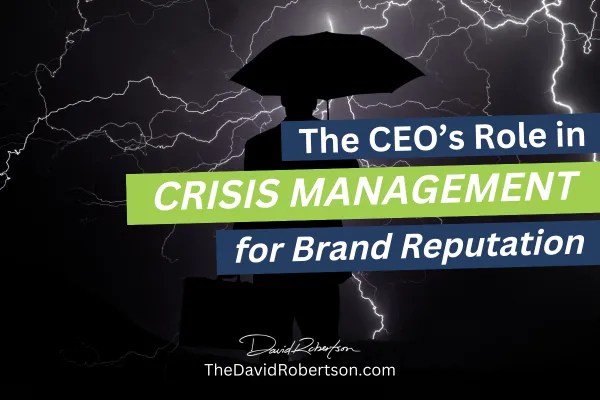

The CEO's Role in Crisis Management for Brand Reputation
In the unpredictable world of business, crises are, unfortunately, a part of the landscape. When a crisis hits, it threatens not just the immediate operational aspects of a business but, crucially, its brand reputation. From my experiences, navigating a company through these times is a complex yet vital part of leadership. Let's explore how a CEO can effectively manage crises to safeguard and even strengthen a brand's image.
Recognizing the Weight of the Situation
The first step in crisis management is recognizing the gravity of the situation and understanding its potential impact on the brand. This is not the time for denial or downplaying. It's crucial to approach the situation with a clear head and a realistic understanding of the potential repercussions.
Rapid Response and Communication
When a crisis unfolds, time is of the essence. One of the key roles as a leader is to ensure a swift and coordinated response. This involves assembling a crisis management team and formulating a communication strategy. Communicating quickly doesn’t mean hasty or ill-considered messages; it means being timely and thoughtful in addressing the issue.
Transparency and Honesty
In times of crisis, transparency and honesty are your greatest allies. Stakeholders, including customers, employees, and investors, appreciate and respect forthrightness. It’s about being open about the situation, what is known, what is not, and what is being done. This approach not only helps in maintaining trust but can also prevent misinformation and rumors from exacerbating the situation.
Taking Responsibility
If the crisis is a result of a mistake or oversight by the company, taking responsibility is crucial. This isn't about assigning blame but about owning up to the company's part in the situation. It demonstrates accountability and a commitment to rectifying the issue, which can go a long way in preserving the brand's integrity.
Consistent Messaging Across All Channels
Ensure that the messaging is consistent across all communication channels - be it press releases, social media, internal communications, or customer service. Inconsistent messaging can lead to confusion and further damage the brand's reputation.
Employee Engagement and Support
Employees are the backbone of any company, and during a crisis, they need to be well-informed and supported. They are often the first point of contact with customers and other stakeholders, so ensuring they understand the situation and the company’s response is essential. Keeping the team informed and engaged helps maintain morale and a united front.
Learning and Adapting from the Crisis
Every crisis, while challenging, is also an opportunity to learn and grow. Analyzing what went wrong, what was handled well, and what could have been done better is an important step. This learning process should lead to implementing new strategies or modifying existing ones to prevent similar crises in the future.
Maintaining a Focus on Core Values
In the midst of a crisis, it’s easy to get caught up in the immediate response and forget the broader picture. Maintaining a focus on the company’s core values is essential. These values should guide every decision and action during the crisis, ensuring that the response aligns with what the brand stands for.
Building a Resilient Brand
Post-crisis, there's an opportunity to build a more resilient brand. This involves reviewing and strengthening crisis management protocols, enhancing communication strategies, and reaffirming the brand’s commitment to its values and stakeholders.
Engaging with Stakeholders Post-Crisis
After a crisis has been managed, continue to engage with stakeholders. This includes providing updates on the steps taken to address the issues and prevent future crises. It also involves listening to feedback and concerns. This continued engagement demonstrates ongoing commitment and transparency.
In conclusion, a CEO’s role in crisis management is multifaceted. It requires quick thinking, decisive action, transparency, and a focus on the long-term implications for the brand’s reputation. While no one wishes for a crisis, handling it effectively can not only mitigate damage but also demonstrate the strength and resilience of the brand. It’s about steering the ship through rough waters with a steady hand and an eye on the horizon, always remembering that how a crisis is managed can leave a lasting imprint on the brand's image.
David Robertson is a Private Equity Investor, Speaker, and Business Mentor to CEO's around the world. He writes at TheDavidRobertson.com, a platform dedicated to helping business leaders navigate the complexities of growing a company in today's business environment.

The CEO's Role in Crisis Management for Brand Reputation
In the unpredictable world of business, crises are, unfortunately, a part of the landscape. When a crisis hits, it threatens not just the immediate operational aspects of a business but, crucially, its brand reputation. From my experiences, navigating a company through these times is a complex yet vital part of leadership. Let's explore how a CEO can effectively manage crises to safeguard and even strengthen a brand's image.
Recognizing the Weight of the Situation
The first step in crisis management is recognizing the gravity of the situation and understanding its potential impact on the brand. This is not the time for denial or downplaying. It's crucial to approach the situation with a clear head and a realistic understanding of the potential repercussions.
Rapid Response and Communication
When a crisis unfolds, time is of the essence. One of the key roles as a leader is to ensure a swift and coordinated response. This involves assembling a crisis management team and formulating a communication strategy. Communicating quickly doesn’t mean hasty or ill-considered messages; it means being timely and thoughtful in addressing the issue.
Transparency and Honesty
In times of crisis, transparency and honesty are your greatest allies. Stakeholders, including customers, employees, and investors, appreciate and respect forthrightness. It’s about being open about the situation, what is known, what is not, and what is being done. This approach not only helps in maintaining trust but can also prevent misinformation and rumors from exacerbating the situation.
Taking Responsibility
If the crisis is a result of a mistake or oversight by the company, taking responsibility is crucial. This isn't about assigning blame but about owning up to the company's part in the situation. It demonstrates accountability and a commitment to rectifying the issue, which can go a long way in preserving the brand's integrity.
Consistent Messaging Across All Channels
Ensure that the messaging is consistent across all communication channels - be it press releases, social media, internal communications, or customer service. Inconsistent messaging can lead to confusion and further damage the brand's reputation.
Employee Engagement and Support
Employees are the backbone of any company, and during a crisis, they need to be well-informed and supported. They are often the first point of contact with customers and other stakeholders, so ensuring they understand the situation and the company’s response is essential. Keeping the team informed and engaged helps maintain morale and a united front.
Learning and Adapting from the Crisis
Every crisis, while challenging, is also an opportunity to learn and grow. Analyzing what went wrong, what was handled well, and what could have been done better is an important step. This learning process should lead to implementing new strategies or modifying existing ones to prevent similar crises in the future.
Maintaining a Focus on Core Values
In the midst of a crisis, it’s easy to get caught up in the immediate response and forget the broader picture. Maintaining a focus on the company’s core values is essential. These values should guide every decision and action during the crisis, ensuring that the response aligns with what the brand stands for.
Building a Resilient Brand
Post-crisis, there's an opportunity to build a more resilient brand. This involves reviewing and strengthening crisis management protocols, enhancing communication strategies, and reaffirming the brand’s commitment to its values and stakeholders.
Engaging with Stakeholders Post-Crisis
After a crisis has been managed, continue to engage with stakeholders. This includes providing updates on the steps taken to address the issues and prevent future crises. It also involves listening to feedback and concerns. This continued engagement demonstrates ongoing commitment and transparency.
In conclusion, a CEO’s role in crisis management is multifaceted. It requires quick thinking, decisive action, transparency, and a focus on the long-term implications for the brand’s reputation. While no one wishes for a crisis, handling it effectively can not only mitigate damage but also demonstrate the strength and resilience of the brand. It’s about steering the ship through rough waters with a steady hand and an eye on the horizon, always remembering that how a crisis is managed can leave a lasting imprint on the brand's image.
David Robertson is a Private Equity Investor, Speaker, and Business Mentor to CEO's around the world. He writes at TheDavidRobertson.com, a platform dedicated to helping business leaders navigate the complexities of growing a company in today's business environment.
